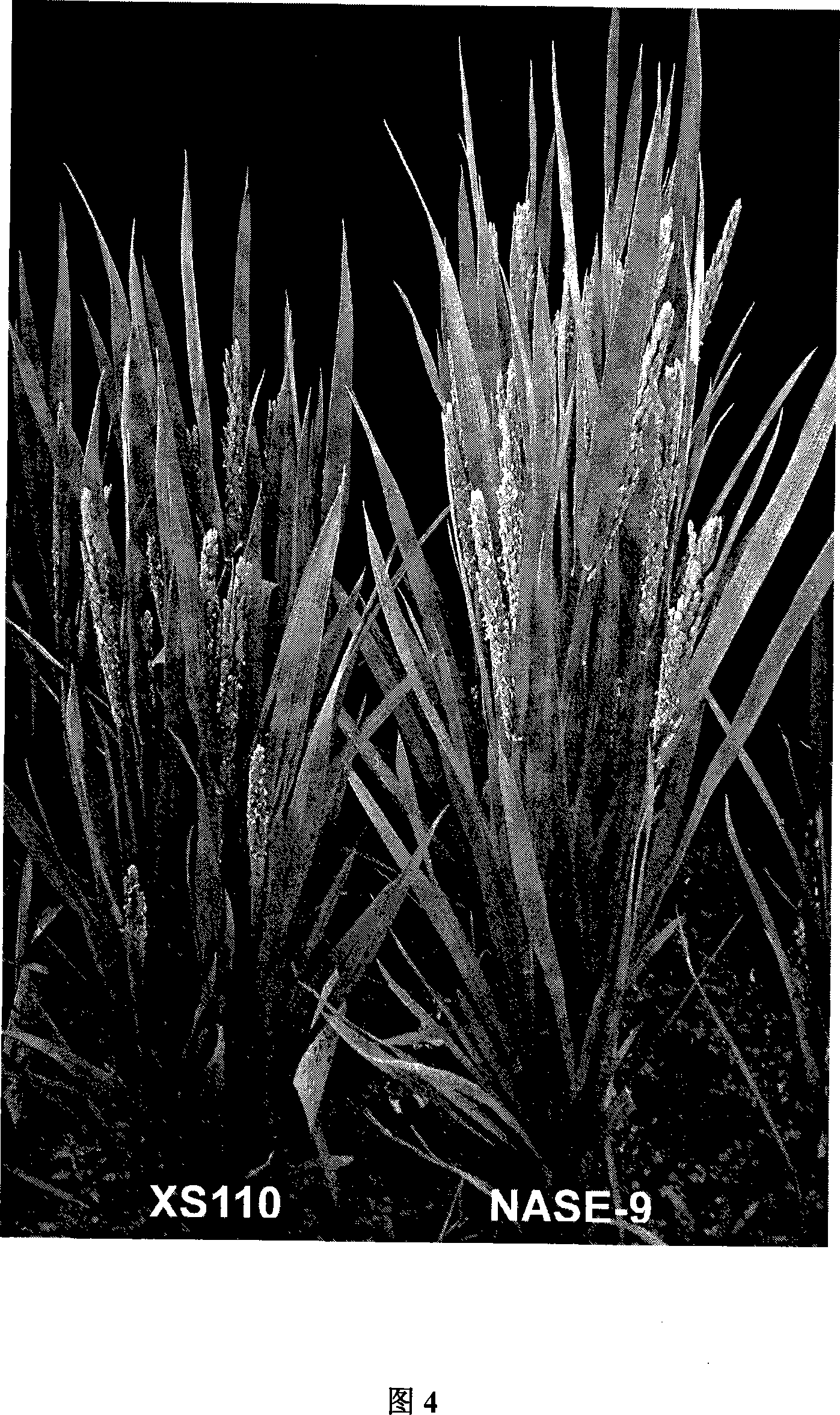Method for breeding transgenic crop with iron/zinc and nicotinamide rich grains and uses thereof
A technology of nicotinamide and crops, which is applied in the field of crop breeding and genetic engineering, can solve the problems of high cost, expression of NAS gene, difficulty in promotion, etc., achieve great application prospects, improve iron bioavailability, and alleviate iron-deficiency malnutrition Effect
- Summary
- Abstract
- Description
- Claims
- Application Information
AI Technical Summary
Problems solved by technology
Method used
Image
Examples
Embodiment 1
[0067] Embodiment 1, the isolation of rice nicotinamide synthetase gene:
[0068] Through data mining of the rice gene bank, we obtained the sequence of the rice nicotinamide synthase gene (OsNAS1, gene bank sequence number AB046401), as shown in SEQ ID NO: 1; and the rice glutenin synthase gene promoter (GluB -1, GenBank sequence number AY427569), as shown in SEQ ID NO:2. And according to these two sequence design primers, this primer sequence is as follows:
[0069] OsNAS1-U: AACCATGGAGGCTCAGAACCAAGA
[0070] OsNAS1-L: TATCTAGA GATCGTCCGGCTGTTAGAC
[0071] GluB-U: ATGAATTCTTGCTACCAACAACTTCAC
[0072] GluB-L: AACCATGGGCTGGGCCATAGAACCGTGGCATA
[0073] Then, the above two DNA sequences, ie, SEQ ID NO: 1 and SEQ ID NO: 2, were amplified from rice cDNA and genomic DNA respectively by using a polymerase chain reaction program.
Embodiment 2
[0074] Embodiment 2, construction of endosperm-specific expression transgene vector:
[0075]The binary vector pTF101.1 (Figure 1) is a plant transgenic vector mediated by Agrobacterium, in which there is a complete selection marker gene expression cassette, that is, glufosinate driven by a double 35S promoter resistance gene. There is a multiple cloning site available for gene cloning on the side of the gene expression frame. In this experiment, the rice gluten synthase gene promoter GluB-1 and the Agrobacterium tumefaciens nopaline synthase gene terminator Tnos (such as SEQ ID NO: 3 shown) to obtain the intermediate vector pLU10 (Fig. 2); between the GluB-1 promoter and the Tnos terminator of the intermediate vector pLU10, the rice nicotinamide synthetase gene (OsNAS1) was forward inserted to obtain the final vector pLU14 for transgenic use ( figure 2).
Embodiment 3
[0076] Embodiment 3, rice transformation:
[0077] The binary transgenic vector pLU14 and its blank vector pLU10 were transformed into Agrobacterium tumefaciens strain EHA105 by electroporation to transform rice. Mature seeds of Xiushui 110 were dehulled and sterilized, and after being cultured in induction medium for 3 weeks, vigorously growing calli were selected as recipients for transformation. The rice callus was infected with the EHA105 strain containing the binary plasmid vector, cultured in the dark at 25°C for 3 days, and then selected on the selection medium containing 2 mg / L bialaphos (bialaphos) for four weeks to obtain resistant callus. The wounded tissue was differentiated and regenerated to obtain transgenic seedlings. After the seedlings were sprayed with 100mg / L of glufosinate on the leaves to remove the false positive seedlings, the transgenic seedlings were transferred to the solution culture for 2 weeks, and then transplanted to the paddy field cultivation...
PUM
 Login to View More
Login to View More Abstract
Description
Claims
Application Information
 Login to View More
Login to View More - R&D
- Intellectual Property
- Life Sciences
- Materials
- Tech Scout
- Unparalleled Data Quality
- Higher Quality Content
- 60% Fewer Hallucinations
Browse by: Latest US Patents, China's latest patents, Technical Efficacy Thesaurus, Application Domain, Technology Topic, Popular Technical Reports.
© 2025 PatSnap. All rights reserved.Legal|Privacy policy|Modern Slavery Act Transparency Statement|Sitemap|About US| Contact US: help@patsnap.com



